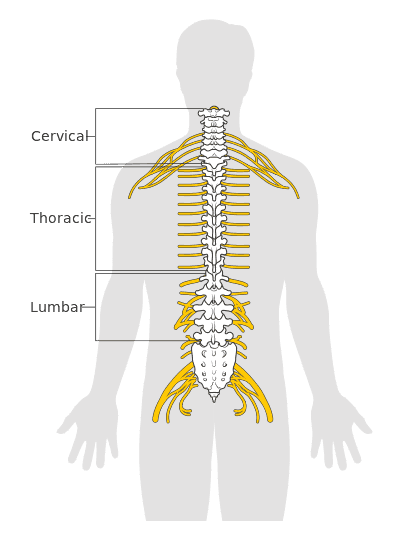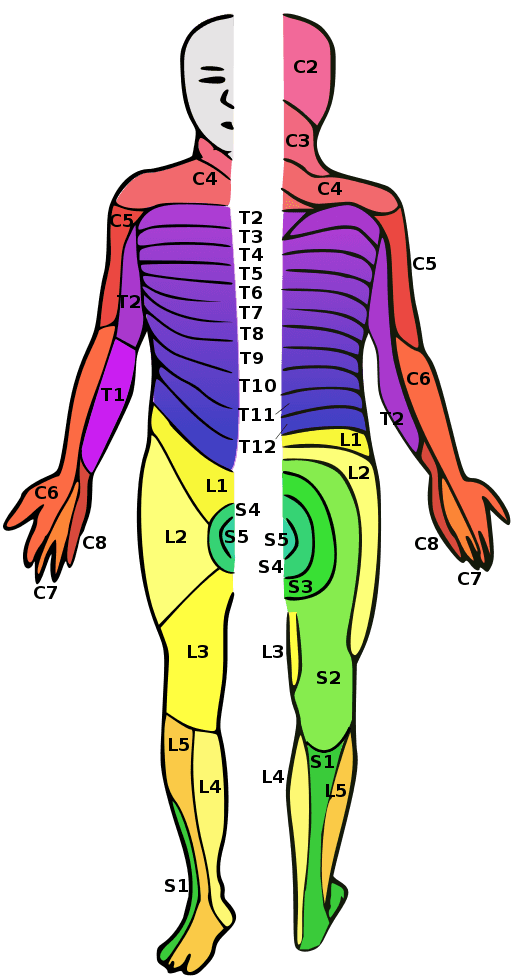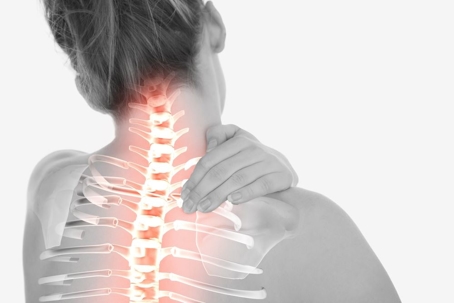The spinal cord a long, thin tubular bundle of nervous tissue with 31 pairs of spinal nerves. Each pair of nerves controls specific functions in your body – from your legs to your bowel to your shoulder and toes (and more). What spinal damage can occur as a result of car accidents?
The spinal cord extends from the medulla oblongata (in the brainstem) to the lumbar (lower back region) of the vertebral column. The spinal column varies in length between genders (45 cm in men and 43 cm in women), and width (13 mm in the cervical and lumbar regions and 6.4 mm in the thoracic/back area). It can often be thought of like a spongy bit of string cheese that extends down to your mid back and then the spinal nerve roots take over from the length of the back and neck all the way to your coccyx; everything is protected by bones and discs. It functions to transmit nerve signals throughout the body. If the spinal cord is damaged, it can cause life-changing problems. Spinal damage is often caused in serious car accidents but they can also be caused by other factors too.
We’ll talk about the definition of spinal cord damage, and 2 types of spinal cord injuries from car accidents.
What Is Spinal Cord Damage?
A spinal cord injury occurs when the spinal cord has been damaged, either temporarily or permanently, resulting in impairment in the cord’s normal motor, sensory, or autonomic function. Spinal cord injury is not to be confused with spinal (bone) injury as a person can break his or her back or neck without damaging the spinal cord itself. Furthermore, damage to the lumbar nerves such a slipped disk are unlikely to result in paralysis.
Knowing how the spinal cord works can help you understand the possible types of spinal cord injuries resulting from a car accident. Car and motorcycle accidents account for more than 35% of new spinal cord injuries each year.

There are only 2 types of injuries: complete and incomplete, but they can occur anywhere along the spinal column:
1. Complete Injury
In a complete injury, a person loses the ability to feel and move below the level of injury. With car accidents, most injuries occur when there’s a blow to the body causing fractures, dislocations, crushes, or compressed vertebra. When the body experiences trauma to the face, head, and neck the spine will flex beyond the normal range of motion, and the cord may be damaged completely.
2. Incomplete Injury
An incomplete injury allows some function. With car accidents, damage can occur over days or weeks from bleeding, swelling, inflammation, and fluid accumulation in and around the spinal cord. Trauma from a car accident can result in disc injury, which is most common.
Cervical spinal cord
- Top portion of spinal cord that connects to the brain
- Eight vertebrae
- C1-C8 (C1 is at the top, and C8 is at the bottom)
- C8 is where the nerve roots exit the spine. C8 is not pictured in the diagram to the left because there is no corresponding vertebra for it. The nerve root controls finger and hand muscles.
Thoracic spinal cord
- Middle of the spinal cord
- Twelve vertebrae
- T1-T12
Lumbar spinal cord
- Lower region of the spinal cord (where you can feel your lower back bend inward)
- Five vertebrae
- L1-L5
Sacral spine
- Lower, triangle shaped region
- Five vertebrae
- Bends slightly outwards
- No actual spinal cord here
- Made of nerve roots
Coccygeal region
- Known as the coccyx or tailbone
- 1 vertebra at the base of the spinal cord
Paralysis

With spinal cord damage, paralysis can occur in varying degrees, which means you’re unable to move underneath the injury site.
- Monoplegia: paralysis in one limb
- Hemiplegia: paralysis one arm and one leg on one side of the body
- Paraplegia: paralysis in both legs – sometimes the pelvis and lower body as well
- Tetraplegia: paralysis in both arms and both legs (also known as quadriplegia)
The diagram to the right demonstrates where the injury can occur and which portions of the spinal cord control respective body parts. For example, damage to the lumbar spine could result in lower limb paralysis (or some level of paralysis). Damage to the cervical spine could result in monoplegia of an arm – or restricted movement. Cervical spine damage can also lead to paralysis of the legs, trunk, or hands but with shoulder movement. Injuries vary greatly.
Spinal cord damage from a car accident often requires physical therapy, mental therapy, medication, and surgery. Spinal injuries treated immediately have the highest chance of recovery.
What to Do Next
If you’ve been injured in a car accident and sustained spinal cord injury, you may be eligible for compensation. Contact an experienced personal injury lawyer today. At Coxwell & Associates, we have worked on my auto traffic accidents that resulted in spinal cord injury, and have helped many Mississippians. Get in contact with us today for a consultation.
Disclaimer: This blog is intended as general information purposes only, and is not a substitute for legal advice. Anyone with a legal problem should consult a lawyer immediately.

